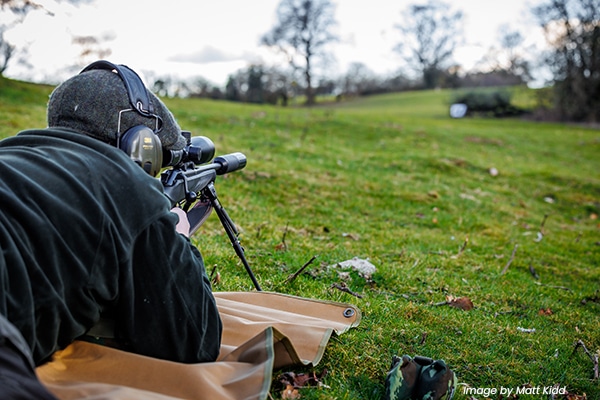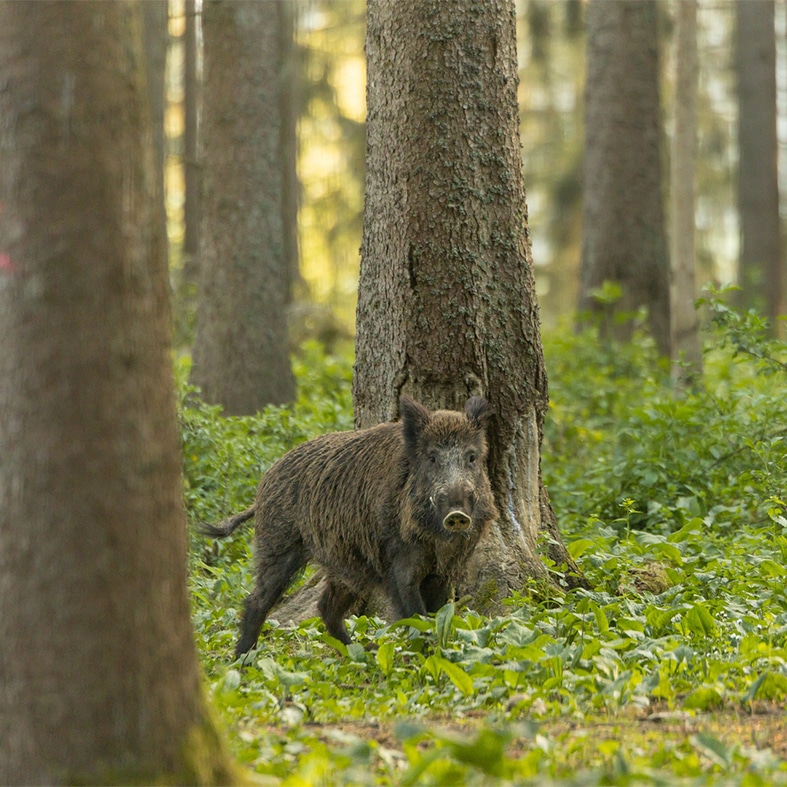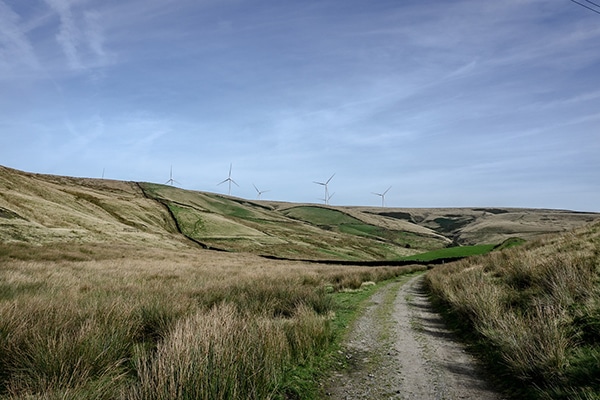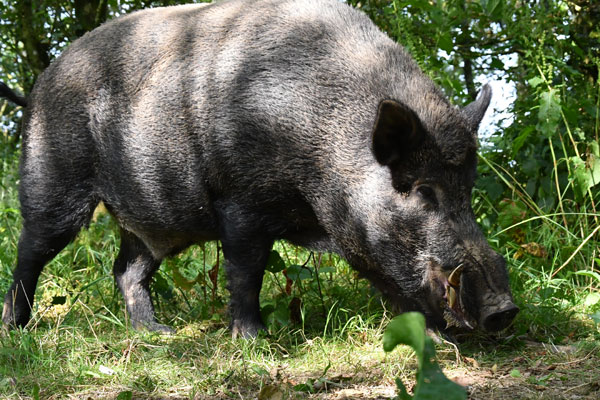
How can I try it?
Deer stalking is a rapidly growing pastime in the UK which is hardly a surprise but how can you get started?
Get information on the legal shooting season for mammals and birds in the UK.
Learn about our current conservation projects and how you can get involved.
Comprehensive information and advice from our specialist firearms team.
Everything you need to know about shotgun, rifle and airgun ammunition.
Find our up-to-date information, advice and links to government resources.
Everything you need to know on firearms law and licensing.
All the latest news and advice on general licences and how they affect you.


Deer Management Wild boar
Though many people aren’t aware, the UK has a growing population of wild boar. Much like deer, boar in the UK have no natural predators, so it falls to us to manage their numbers to keep populations in check to limit the huge damage that boar can cause.
Wild boar (Sus scrofa) were once native to Great Britain but became extinct some 300 years ago. However, following escapes or deliberate releases from wild boar farms or animal collections, they have now established breeding populations in the wild.
The main colonies are in and around the Forest of Dean, Kent/Sussex, Dorset, South Wales and a growing number of areas in Scotland.
Adult males weigh in the region of 120 to 150kg and will stand 70 to 90cm at the shoulder with an overall body length of approximately 150cm. These animals will possess sharp tusks which will grow progressively from two years of age.
Females are about 30 per cent lighter in weight than males and both sexes have a mane of longer hair running down their backs.
Piglets are red-brown to ochre coloured, with yellowish longitudinal stripes for the first four to five months. This coat is then moulted to a uniform red-brown fur which in turn develops into the adult coat at about 10 to 12 months.
With good feeding, both sexes can mature in under a year. Sows can come into heat between October and May but the height of the season is between November and January.
Subordinate females coming into season may be synchronised with the dominant sow. Gestation is three months, three weeks, three days. They are prolific and regular breeders, with litter sizes increasing with age.
When food is abundant, sows can produce two litters a year and this poses issues over the practicality of a close season. They have the potential for very rapid population growth if not actively managed.
Wild boar live in hierarchical groups of females and young, usually led by the oldest sow. Sows generally only leave the group to look after newborn piglets until they are about two-weeks-old. The sow will normally make a farrowing nest out where the litter will be delivered.
Other than during the breeding season, fully grown males tend to be solitary, roaming around their territories. Groups of young males often stick together during summer after being pushed out by females before farrowing.
The keeping of farmed wild boar is controlled under the Dangerous Wild Animals Act 1976. This means that anyone farming wild boar must have a licence from the local authority.
The keeping of wild boar for exhibition to the public in zoos and wildlife parks is controlled by the Zoo Licensing Act 1981. Both the Classical Swine Fever (England) Order 2003 and the African Swine Fever (England) Order 2003 make provisions for notification of the disease in feral pigs (including wild boar) and restriction of hunting of feral pigs (wild boar) in designated investigation or infected areas.
Feral wild boar have no specific legal protection but are covered by more general legislation covering mammals in the wild, such as the Wild Mammals Protection Act 1996 and the Wildlife and Countryside Act 1981.
There are a number of best practice guides covering various aspects of boar management that, while not legal, should be considered essential reading for those with an interest in boar management in the UK.
Wild boar exist on a diet that is predominantly vegetarian but, being omnivorous, they are extremely capable of capitalising on any food source that presents itself. Their habit of rooting through the floor of woodland and pasture leaves a dramatic indicator of their presence.
They will take both eggs and nestlings of ground-nesting birds and are unlikely to be tolerated by those with game shooting interests as feeders, cover crops and release pens may also be subject to their unwanted attention.
Damage to agriculture can be extensive if the population is allowed to increase unchecked. There are some reports of boar taking lambs and they will most certainly feed on any carrion that they find.
Wild boar are likely to be managed by shooting, trapping, or exclusion by fencing. They pose very little threat to humans as long as they are not unduly disturbed; during the breeding season any sow with piglets should be given a wide berth. When injured or wounded, a wild boar can be very unpredictable.
Wounded animals need to be followed swiftly to ease their suffering and this activity requires sound planning with appropriate equipment, dogs and firearms. BASC has previously recommended that a minimum calibre for shooting this species under UK conditions should be .270 rifle with a suitably heavy bullet.
The Any Other Lawful Quarry condition on your certificate will allow you to shoot boar in the UK. Without this, you will need a specific condition for boar.
The crucial component of any cull management plan will ensure that breeding sows are not shot when they are lactating and have dependent young. As has been previously mentioned, there is no defined season when litters will be born so most culling operations are likely to concentrate on males and immature females.
Trapping of such a large animal is a very specialised area and it needs detailed consideration before being contemplated. Further advice can be obtained from BASC’s deer team if required and fencing specifications will be produced as part of the best practice guidance.
It is not illegal to shoot boar at night or under the moon and in areas of high disturbance or culling pressure, this intelligent animal is likely to become exclusively nocturnal. Under such conditions it is even more important to ensure that the correct sex and age class of animal is selected.
Wild boar are subject to carrying a parasite called Trichinella. This can be passed onto humans, as well as other animals, through the meat.
As part of an ongoing monitoring programme, the Animal and Plant Health Agency (APHA) has instigated a Trichinella testing scheme available to stalkers who are shooting wild boar and wish to put the meat into the food chain.
Sampling kits are supplied free of charge, with postage-paid envelopes included. The detailed location of where the animals are shot remains confidential and APHA aims to inform the stalker within two days of the results. It is very simple to take the sample; all that is required is small piece (5cm2) of the diaphragm from close to the chest wall or a piece from the foreleg or back of the tongue.
Anyone interested in registering for the scheme and receiving sampling kits, or anyone with any questions regarding the service should contact APHA at NRL.Parasitology@apha.gov.uk
African Swine Fever (ASF) is a disease that affects all species of pigs, including wild boar. It is highly contagious between pigs and represents a serious threat to pork markets across the world.
There are currently increasing cases of ASF across Europe, including Belgium and Germany. Please follow all government advice regarding ASF when visiting these countries, particularly if hunting wild boar.

Wild boar used to be native, but they became extinct about 300 years ago due to habitat loss and overhunting.
No. Most of the animals have escaped from animal parks or wild boar farms. These animals have now bred and the population is increasing.
No. Wild boar have no predators in the UK except man.
Currently there are no specific provisions giving formal legal protection to wild boar or controlling their management and culling. However animals caught in traps are protected against unnecessary suffering by the Animal Welfare Act 2006. Wild boar living freely in the wild are protected against specific acts of cruelty by the Wild Mammals (Protection) Act 1996.
Wild boar or their hybrid offspring can only be kept under a licence issued in accordance with the Dangerous Wild Animals Act 1976. Premises where they are kept are subject to inspection to see that they are secure and that the animals are properly cared for. Licences are obtainable from the relevant local authority. The keeping of wild boar for exhibition to the public in wildlife and farm parks is covered by the Zoo Licensing Act 1981.
The release of wild animals including non-native species is controlled by The Wildlife and Countryside Act 1981. Part 1 section 14 of the act makes it an offence to release, or allow to escape into the wild, any animal of a kind which is “not ordinarily resident in and is not a regular visitor to Great Britain in a wild state”.
Section 27 then defines a number of terms used in part 1, but strangely does not give any definition of “ordinarily resident”. There is now a need for guidance on whether wild boar having existed in a feral state for many years could be considered as ordinarily resident.
Neither the Dangerous Wild Animals Act 1976 nor the Dangerous Wild Animals Act 1976 (Modification) Order 1984 makes any provision to require a licensee to take any action to recover escaped animals.
Under Section 6 of the act, local authorities have the power to seize any animal(s) and retain or destroy them, if any animal is being kept contrary to the act or any condition of the license under which it is being held. It has not been tested yet whether these powers could potentially be used to recapture escaped animals at the licensee’s expense.
No. As wild boar were formerly a native species they should have a beneficial effect since they are replacing a lost part of the ecosystem. Scientific studies including work done by the University of Sussex suggest that although rooting of the soil can cause damage to carpets of bluebells, this impact is generally localised and short-lived and plants regrow in following years with increased vigour. Rooting also encourages the growth of new plants by uncovering dormant seeds in the soil. However there is some evidence that rooting in species-rich, semi-natural grassland can encourage colonisation by invasive weed species.
Yes. Particularly if their sources of natural food are in short supply. Boar feed on a wide variety of food and will readily feed on agricultural crops. Favourite crops include sugar beet, maize, potatoes, oats, wheat and grassland. In England, most of the damage reported has been damage to maize crops and rooting in grassland.
Wild boar will also eat carrion such as dead livestock, and they have been reported to take dead and very weak lambs.
No, if left well alone. The boar will most likely move away from the guns and beaters before the drive starts. They are only likely to attack if cornered or threatened.
Potentially, yes. Wild boar are very large, tough animals. Their chest cavity is well protected by a thick plate of cartilage, muscle and fat, which usually requires a deep penetrating bullet to humanely control mature specimens. Wounded animals can become very aggressive and attack the hunter or worse, escape and attack people out in the countryside.
Therefore the suggested minimum calibre which is accepted by most police forces is .270 and 130grain bullet and a minimum muzzle energy of 2600ft/lbs.
This should be regarded as the absolute minimum and larger calibre rifles should be used if possible. The 9.3 calibre rounds are very popular on the continent and are well proven for wild boar. It could be argued that .375 and larger calibres should also be allowed for wild boar.
Twelve bore or larger shotguns using only a single projectile (rifled slug) can also be suitable for wild boar in certain conditions.
Yes. There are no restrictions on shooting wild boar at night as wild boar have no specific legal status. However it is important to behave in a humane manner at all times, and to prevent any act of cruelty that may leave you open to prosecution under the Wild Mammals (Protection) Act 1996 i.e. do you have procedures and any equipment to follow-up and despatch any wounded animals in the dark.
No. There are no closed seasons for wild boar.
No. Not as a pack of hounds, but two dogs may be used to track and follow-up wounded or injured animals.
With wild boar populations expanding across Europe there is now a growing need for management of the species across the UK.
They are renowned for damaging crops, in particular maize crops, and rooting in grassland.

Deer stalking is a rapidly growing pastime in the UK which is hardly a surprise but how can you get started?


This course is designed for the sportsman or woman as part of their ongoing commitment to humane and responsible hunting of wild boar.
Sign up to our weekly newsletter and get all the latest updates straight to your inbox.
© 2023 British Association for Shooting and Conservation. Registered Office: Marford Mill, Rossett, Wrexham, LL12 0HL – Registered Society No: 28488R. BASC is a trading name of the British Association for Shooting and Conservation Limited which is authorised and regulated by the Financial Conduct Authority (FCA) under firm reference number 311937.
If you have any questions or complaints about your BASC membership insurance cover, please email us. More information about resolving complaints can be found on the FCA website or on the EU ODR platform.
This website uses cookies so that we can provide you with the best user experience possible. Cookie information is stored in your browser and performs functions such as recognising you when you return to our website and helping our team to understand which sections of the website you find most interesting and useful.
Strictly Necessary Cookie should be enabled at all times so that we can save your preferences for cookie settings.
If you disable this cookie, we will not be able to save your preferences. This means that every time you visit this website you will need to enable or disable cookies again.
This website uses Google Analytics to collect anonymous information such as the number of visitors to the site, and the most popular pages.
Keeping this cookie enabled helps us to improve our website.
Please enable Strictly Necessary Cookies first so that we can save your preferences!
More information about our Cookie Policy